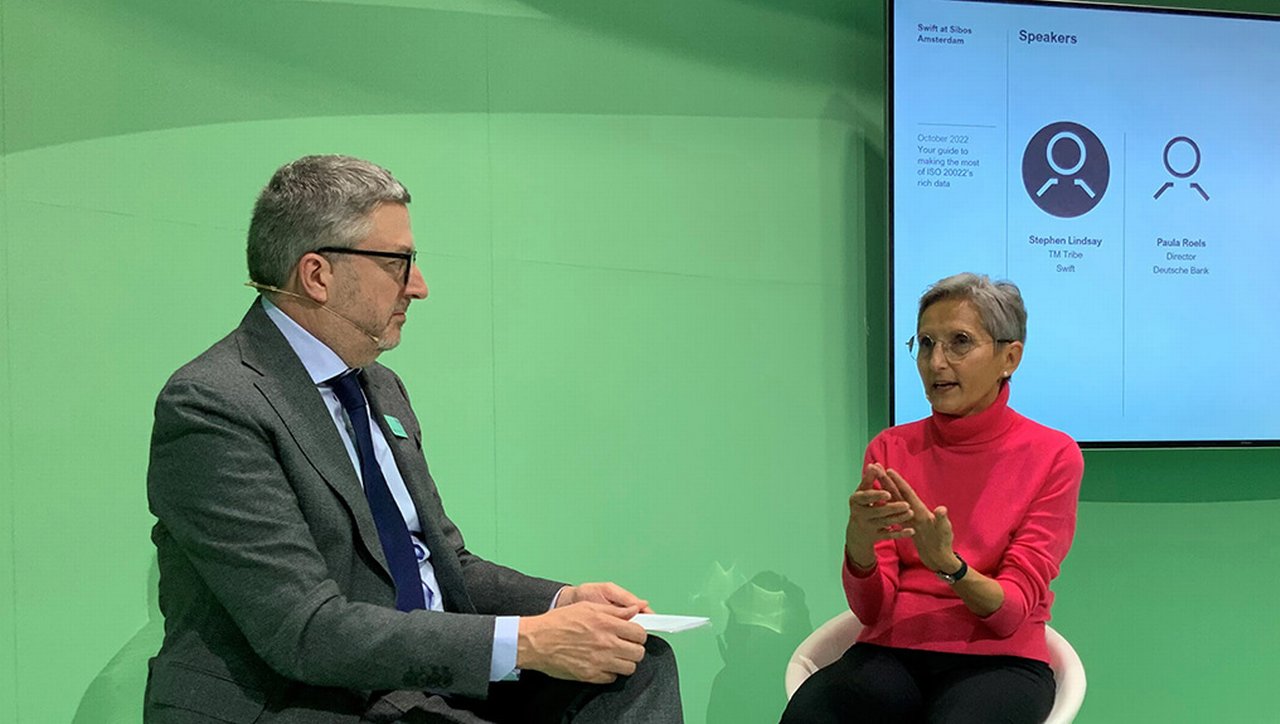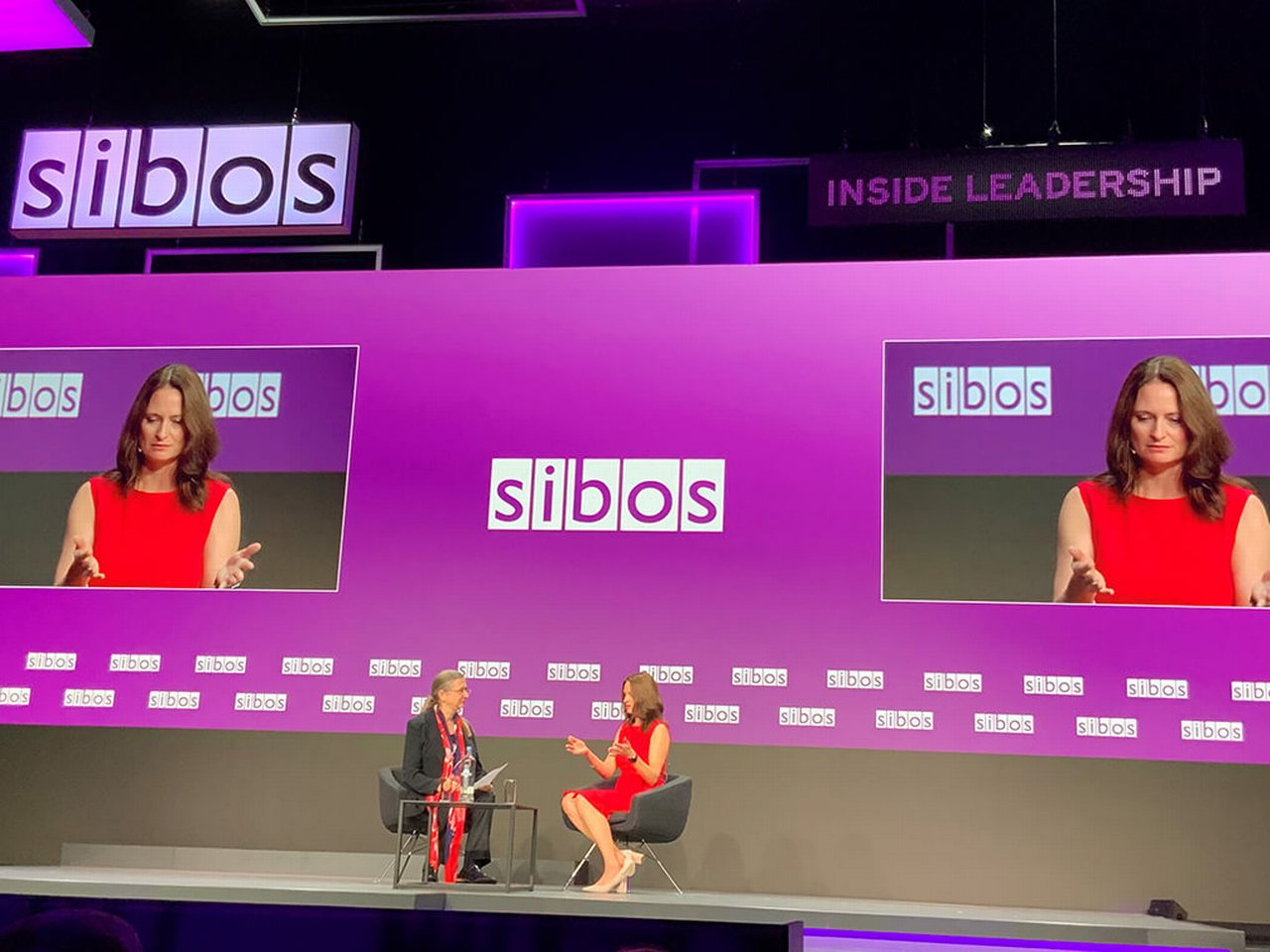20 October 2022
Sibos Amsterdam 2022 returned to an in-person event at the RAI Convention Centre against the backdrop of rising inflation, energy security worries and increased levels of financial crime. In the first of three post-Sibos reports, flow’s Clarissa Dann takes a deep dive into post-pandemic payments
MINUTES min read
With more than 8,000 delegates descending on the RAI Convention Centre in Amsterdam, it was clear that the Sibos community was keen to get back to an in-person event after two years of virtual conferences. However, for 2,000 additional attendees, the virtual option was a practical alternative.
“It’s great to be back, and fitting to be here in Amsterdam as the Netherlands knows what it is like to collaborate, innovate and adapt,” said Javier Tasso-Perez, SWIFT’s CEO, in the opening plenary session. Mairead McGuinness, European Commissioner for Financial Stability, Financial Services and the Capital Markets Union, reiterated the “uncertain” and “challenging” economic environment and the “vital role” the financial system has in supporting the wider economy. “Our challenge is to understand and manage all the risks and to make our way through,” she reflected. And, as keynote speaker, HM Queen Máxima of the Netherlands (and the UN’s Special Advocate for Inclusive Finance for Development) reflected, digital innovation holds tremendous promise for financial inclusion and financial health. “Use this conference to build a secure, trusted and efficient economy that really works for all,” she said.
With 24% of the 11,500 attendees of Sibos London 2019 stating their primary focus was payments, it was hardly surprising that this was a dominant theme at Sibos Amsterdam three years later. Maintaining and upgrading market infrastructure that ensures payments are faster, cheaper, and impenetrable to criminals, while remaining accessible to the financially excluded, remains a top priority. Drawn from a packed four days of more than 150 conference sessions across eight stages, arranged under the broad theme of “Progressive finance for a changing world”, this article is the first of three post-Sibos 2022 reflections and takes a closer look at payments. Subsequent articles will report on securities services, trade finance and lending and how sustainability and digital transformation are reshaping these businesses.
ISO 20022 comes of age
Financial messaging standard ISO 20022, having been something of a fringe discussion 11 years ago at Sibos Toronto 2011 (with give-away copies of the large yellow self-help book ISO 20022 for Dummies), stood out in terms of session frequency as by far the most popular topic at the 2022 conference.
With the November 2022 migration deadline for Target 2, EURO1 and CBPR+ payments looming large, discussion focused on managing the coexistence period – when various market infrastructures will be live with the new data-rich format, while others will continue running legacy SWIFT MT messages.

Stephen Lindsay (Business lead, SWIFT Platform) and Paula Roels (Head of SWIFT & Market Infrastructure, Deutsche Bank) explain how to make the most of ISO 20022’s rich data
Fears of data truncation have been somewhat allayed by SWIFT’s roll-out of the new Transaction Manager, which affords central management of a payment chain. Most notably, the Transaction Manager creates a “transaction copy” of the original ISO 20022 message, explained Paula Roels, Head of SWIFT & Market Infrastructure, Deutsche Bank in one of the Standards Forum sessions, ‘Your guide to making the most of ISO 2022’s rich data’. This means that when rich data is lost due to a bank in the chain not running the new format, this data can be reinserted into the message that is passed onto the next member of the chain.
“ISO is coming, we need to adopt it”
Importantly, the learning points of SEPA migration have been taken on board with ISO 20022, as the community replaces a patchwork of legacy standards, makes incremental step-by-step movements – but at the end of it all, a mandated end date was necessary. The whole ISO 20022 process has created a template for banks’ broader data architectures – offering the structure and standardisation required to process and share data more effectively.

Christian Fraedrich, Head of Business Architecture at Deutsche Bank Corporate Bank explains in a flow video why ISO 20022 needs to be universally adopted (This is on the social media channel, LinkedIn and not clickable from this image)
While the SWIFT Transaction Manger promises to ease the transition and make these benefits more readily available, it is not yet a cure-all for the pains of migration. “Starting from November, all banks need to be capable of receiving MX messages with an embedded MT,” said Christian Fraedrich, Head of Business Architecture at Deutsche Bank Corporate Bank, in the “Meet the experts” session entitled, “The Swift platform: A foundation for future innovation”. He continued, “The Transaction Manager, meanwhile, will only be fully live from April. So, we need to prepare for how we handle truncation issues in the meantime. The Transaction Manager will provide a lot of value, but it won’t solve all problems. In particular, banks do still have to adopt ISO 20022 – they can’t rely on SWIFT to make that go away.” In a follow-up flow interview published on LinkedIn, his call to action was clear, “ISO is coming, and we need to adopt it”.
Making the most of the new data format was also a discussion point. “Clients face reconciliation issues at the moment,” said Marc Recker, Global Head of Product, Institutional Cash Management, Deutsche Bank, a speaker in the packed session Powering payments: the dawning of a data-rich era’ on Day 1. “At the moment, there is too much free text data, which slows down reconciliation and can cause confusion with compliance and sanctions.” Isabel Schmidt, Co-Head of Global Payment Products, BNY Mellon concurred, “If you know someone lives in Cuba Street, rather than in Cuba, that makes a big difference to how quickly you can complete risk checks.”
“The collaboration we have seen over the past couple of years is already continuing”
In a flow video interview posted on LinkedIn shortly afterwards, Recker said, “What is clear, the collaboration we have seen over the past couple of years is already continuing and delivering superior experience for our clients.”
The role of agile data management underpinning all of this is explained by the Corporate Bank’s Chief Data Officer Christopher Daniels in the flow article, ‘Seize the data’, published just before Sibos.
Faster payments
Connecting instant payment systems across borders
As formats and standards align, the barriers to faster cross-border payments reduce. One of the major talking points at Sibos was the collaboration between The Clearing House and EBA CLEARING on the new Immediate Cross-Border (IXB) solution, which links together the US RTP and EU RT1 instant payment systems, together with key components from SWIFT. The pilot programme for the service is under way and the collaborators announced just ahead of the conference that it is on track for commercial roll-out in 2023.1
Outside the traditional market infrastructures, however, disruptors continue to plot their own course towards instant cross-border payments using distributed ledger technology (DLT)-based rails. One of the key challenges here is to create safer and more regulated DLT rails, but many market participants are optimistic that this can be addressed and excited about the future possibilities – ranging from atomic settlement to programmable money (though here too, incumbents will argue the same can be achieved using traditional infrastructure.2
“I think of instant treasury as clients having access to the right information at the right time to make the right decisions”
Instant treasury
As instant payments look set to reach across borders, what does this mean for “instant treasury”? As Christof Hofmann, Global Head of Corporate Cash Management, Deutsche Bank told LinkedIn followers after his session, ‘Digital Payments Transformation: The Future of Competitive Advantage in Banking & Payments’, “it does not mean the same for everyone and we really have to listen to our clients”. He continued, “I think of instant treasury as clients having access to the right information at the right time to make the right decisions. This could be using instant payments, but not necessarily.”
With more of this instant information being available, the challenge for corporates is having the right tools and processes in place to make full use of it. That could mean having analytics that not only flag, for example, when a payment needs to be made, but also how it should be made (by ACH? RTS? Wire?).
Yet for this to be effective, you also need to bring in the right data in the right way – and standardisation of the application programming interfaces (APIs) – the tools used to share data between systems – remains a sore point. There is work being done to ease this challenge, however. SWIFT continues to offer support on API standardisation through its library of API standards, while corporates can also work with specialist fintech integrators, to better connect their own systems with those of different partners.
Central bank digital currencies
Interest continues to mount in central bank digital currency (CBDC) initiatives such as the ECB's exploration into a Digital Euro, for which advice on the potential issuance, design and implementation is expected in Q3 2023.3
Collaborative efforts are also under way in Asia-Pacific, where the Reserve Bank of Australia (RBA), the Central Bank of Malaysia, the Monetary Authority of Singapore, and the South African Reserve Bank are working on Project Dunbar – a platform for international settlements using multiple CBDCs.4 On 9 August 2022, the RBA announced its collaboration with the Digital Finance Cooperative Research Centre (DFCRC) on a research project to explore use cases for a central bank digital currency (CBDC) in Australia.5 But do central banks see CBDCs as top of the priority list?
It was Dinesh Khara, Chair of the State Bank of India who underlined the point that countries that already have modern and well-functioning payment and settlement systems would simply see digital versions of currencies all converging at the balance sheet level.

Inside Leadership with Susan Foley, Deputy Director, Reserve Bank Operations and Payment Systems of the Federal Reserve Board of Governors in conversation with Katharine Morton, Head of Trade, Treasury & Risk at TXF Limited
In an Inside leadership plenary session on Day 4, Susan Foley, Deputy Director, Reserve Bank Operations and Payment Systems of the Federal Reserve Board of Governors, noted that CBDCs make sense, and “it is captivating to think about a new digital-native form of currency”, but she did not dwell on CBDCs at all, instead moving the discussion straight on to the Fed’s new “transformational payment system relating to instant payments”. Built on a “cloud-first design,” FedNow was first announced in 2020 and intended to serve as an alternative to the existing private-sector real-time payments system. It is slated for launch in mid-2023 and will be available to depository institutions in the US, enabling individuals and businesses to send instant payments through their depository institution accounts. 6
“The Fed took a long time to make a decision to implement an instant payments service,” reflected Foley. She explained how the Fed works alongside the private sector both in cooperation and competition, spurring innovation and efficiency in the payments system. “The cloud-first design sets us up for the future in terms of scalability and throughput. FedNow will be always on,” she said.
The road ahead
In October 2021, the Financial Stability Board set quantitative global targets for addressing the four challenges faced by cross-border payments (cost, speed, access, transparency) as a key foundational step in the G20 Roadmap.7 These targets were set for each of the three main segments of the market (wholesale, retail and remittances).
Twelve months later, the roadmap has, said Dean Sposito, Head of Institutional Cash Management, Western Europe at Deutsche Bank, “been raised to the level of high politics”. In an interview with Finextra TV’s Debi Bell-Hosking, he reflected that, while good progress had been made on speed (“gpi connected the world – we proved we could do it”) and transparency (moved forward by ISO 20022), “one outstanding item harder to solve is access and financial exclusion”. This, he explained, is important for the political arena but “a bit disconnected from the banks and regulatory side”. Each bank has its risk appetite, and this makes the piece around financial inclusion more difficult.
However, the sheer delight from everyone at Sibos at all being back together again, and the intensity of the discussions, would suggest that nothing is impossible when there is collective determination.
Sibos 2022 Amsterdam took place at the RAI Convention Centre from 10 to 13 October 2022 and is available virtually to Sibos registrants on demand

Sustainable rain protection at Sibos. Photo © SWIFT
Sources
1 See ebaclearing.eu
2 See ingentaconnect.com
3 See ecb.europa.eu
4 See bis.org
5 See rba.gov.au
6 See federalreserve.gov
7 See fsb.org
Cash management solutions Explore more
Find out more about our Cash management solutions
Stay up-to-date with
Sign-up flow newsbites
Choose your preferred banking topics and we will send you updated emails based on your selection
Sign-up Sign-upSubscribe Subscribe to our magazine
flow magazine is published annually and can be read online and delivered to your door in print
You might be interested in
WHITE PAPERS/GUIDES
Guide to ISO 20022 migration Part 5 Guide to ISO 20022 migration Part 5
As we near the milestone transition dates for cross-border payments and the Eurozone, the ISO 20022 migration is high on the agenda for financial institutions. At its core, it is an exercise in harmonisation, but even harmonisation is susceptible to different approaches – and the risk of data truncation looms as market infrastructures and market participants transition on different timelines.
TECHNOLOGY, CASH MANAGEMENT
Seize the data Seize the data
Businesses globally want to approach their data in a holistic way, but often struggle to gain the traction needed to be successful. flow explores how Deutsche Bank has transformed its data function – and the key learning points from the bank’s journey
CASH MANAGEMENT, TECHNOLOGY
How new tech and CBDCs can simplify payments How new tech and CBDCs can simplify payments
Managing cross-border payments and cash in Asia-Pacific presents its own specific challenges. How can CBDCs and AI help to remove frictions? flow summarises the four key learning points from a recent Economist Impact webinar supported by Deutsche Bank



